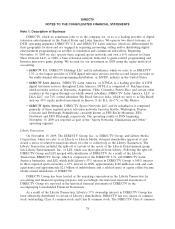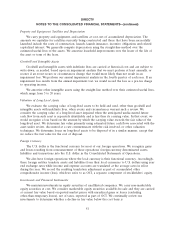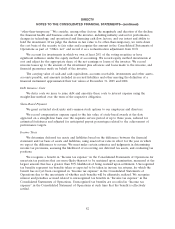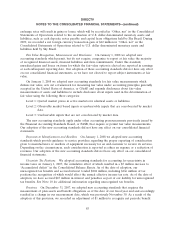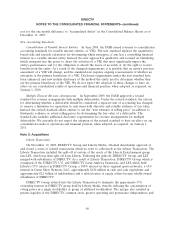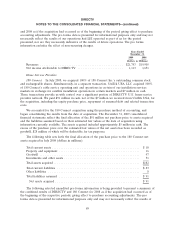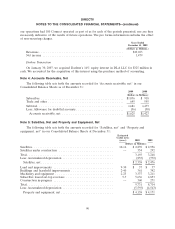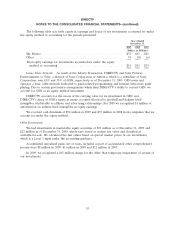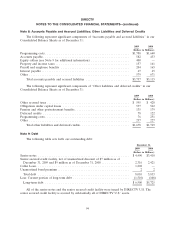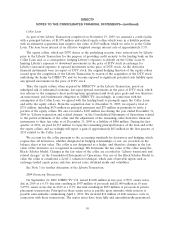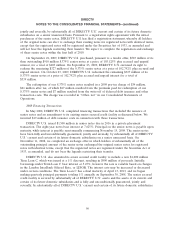DIRECTV 2009 Annual Report Download - page 98
Download and view the complete annual report
Please find page 98 of the 2009 DIRECTV annual report below. You can navigate through the pages in the report by either clicking on the pages listed below, or by using the keyword search tool below to find specific information within the annual report.DIRECTV
NOTES TO THE CONSOLIDATED FINANCIAL STATEMENTS—(continued)
cost for the one month difference to ‘‘Accumulated deficit’’ in the Consolidated Balance Sheets as of
December 31, 2007.
New Accounting Standards
Consolidation of Variable Interest Entities. In June 2009, the FASB issued revisions to consolidation
accounting standards for variable interest entities, or VIEs. The new standard replaces the quantitative-
based risks and rewards calculation for determining which enterprise, if any, has a controlling financial
interest in a variable interest entity. Instead, the new approach is qualitative and focused on identifying
which enterprise has the power to direct the activities of a VIE that most significantly impact the
entity’s performance and (1) the obligation to absorb the losses of an entity or (2) the right to receive
benefits from the entity. As a result of the changed requirements, it is possible that an entity’s previous
assessment of a VIE will change, and the standard now requires ongoing reassessments of whether an
enterprise is the primary beneficiary of a VIE. Disclosure requirements under the new standard have
been enhanced, and now include disclosure of the method the entity used to determine whether they
are the primary beneficiary of the VIE. We do not expect the adoption of these changes to have an
effect on our consolidated results of operations and financial position, when adopted, as required, on
January 1, 2010.
Multiple Element Revenue Arrangements. In September 2009, the FASB approved a revised
standard for revenue arrangements with multiple deliverables. Under the revised standard, the criteria
for determining whether a deliverable should be considered a separate unit of accounting has changed
to remove a limitation for separation to only items with objective and reliable evidence of fair value.
Instead, the revised standard allows entities to use the ‘‘best estimate of selling price’’ in addition to
third-party evidence or actual selling prices for determining the fair value of a deliverable. The
standard also includes additional disclosure requirements for revenue arrangements for multiple
deliverables. We currently do not expect the adoption of the revised standard to have an effect on our
consolidated results of operations and financial position, when adopted, as required, on January 1,
2011.
Note 3: Acquisitions
Liberty Transaction
On November 19, 2009, DIRECTV Group and Liberty Media, obtained shareholder approval of
and closed a series of related transactions which we refer to collectively as the Liberty Transaction. The
Liberty Transaction included the split-off of certain of the assets of the Liberty Entertainment group
into LEI, which was then split-off from Liberty. Following the split-off, DIRECTV Group and LEI
merged with subsidiaries of DIRECTV. As a result of Liberty Transaction, DIRECTV Group, which is
comprised of the DIRECTV U.S. and DIRECTV Latin America businesses, and LEI, which held
Liberty’s 57% interest in DIRECTV Group, a 100% interest in three regional sports networks, a 65%
interest in Game Show Network, LLC, approximately $120 million in cash and cash equivalents and
approximately $2.1 billion of indebtedness and a related series of equity collars became wholly-owned
subsidiaries of DIRECTV.
DIRECTV Group entered into the Liberty Transaction to eliminate the approximate 57%
ownership interest in DIRECTV group held by Liberty Media, thereby reducing the concentration of
voting power in a single stockholder or group of affiliated stockholders. The merger also resulted in
greater liquidity of the DIRECTV common stock, greater operating and governance independence and
86




